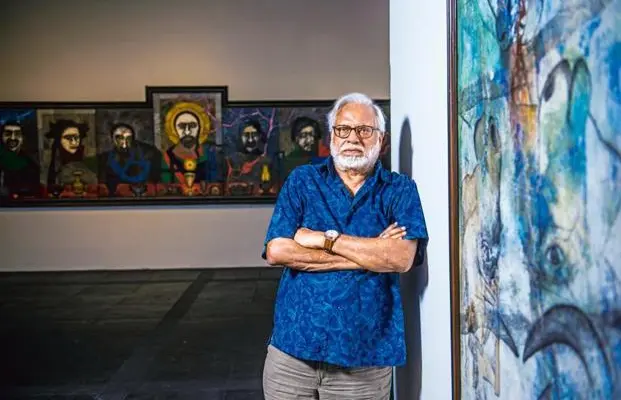
One of India’s most celebrated contemporary artists spoke to Lounge about his life and art, ahead of his Delhi retrospective
 |
| Manu Parekh at the National Gallery. Photo: Pradeep Gaur/Mint |
In a cavernous wing of the National Gallery of Modern Art in Delhi, a man perched on a scissor lift is maneuvering a spotlight attached to the ceiling, to make the beam fall perfectly on a painting on the adjoining wall. The artist of the work sits at a distance, his gaze fixed on the lighting man. Manu Parekh, one of India’s most celebrated modern artists, is overseeing the hanging of his new show at the gallery, a retrospective covering 60 years of his life, which is accompanied by a new book, Manu Parekh: Sixty Years Of Selected Works (Aleph Book Co.).
Parekh, born in Ahmedabad, is most noted for his Banaras series, in which he depicts the colorful and zany “city of light” that never fails to inspire him. The retrospective offers a unique opportunity to explore the artist’s lesser-known, and perhaps unfairly overshadowed works. In an interview, Parekh, who is approaching 80, talks about his life, art, the market and Indian art education. Edited excerpts:
‘Flower From Heaven’ (1995). Photo: Courtesy the artist.
Click here for enlarge
Your flower vases are sometimes reminiscent of Vincent van Gogh or even Ambrosius Bosschaert. To what extent has Western art influenced your work?
See, the moment you do modern art in India, there will be a Western influence. The challenge is how to Indianize this Western element. You have to paint the reality you know and see. I found Paul Klee and (Pablo) Picasso very inspiring.
You have worked in theatre and then as a design consultant in the Indian handloom industry for 25 years. How did that influence your art?
All my life, theatre, and craft have helped me immensely. I look at Banaras with a theatrical eye and approach it like set designing. Secondly, my Heads series, I look at it as an actor. When I’m painting heads, I’m actually painting expressions and situations, because if something’s happening in front of you, only then will there be a reaction on your face. My job in handicrafts took me to many villages where the organic sensibility of rural life deeply affected me.
Did you ever feel you were sanitizing or romanticizing Varanasi, for apart from its spirituality, it’s also one of India’s dirtiest cities?
Filth is everywhere in India, even more so in religious places. That was never my concern, as it’s a political issue which doesn’t interest me at all. I was more concerned about the spirituality and life.
What’s your view on abstraction? If a viewer first has to read an essay to approach a work of art, doesn’t that defeat the purpose of art, which is about “looking” and not “reading”?
Look, if you listen to a classical raga, and you like it, that’s fine. But if you want to talk about it, you’ll need some training and education. Similarly, in art, you can’t just stand in front of the work and be given everything—it’s the same in literature, you have to know the nuances.
But a personal connection with an abstract work is still possible without any knowledge.
Oh, yes, and it should be. Look at Shivalinga—it’s completely abstract. But behind it, there is content. Abstraction for abstraction’s sake doesn’t interest me.
‘Painting is like chanting a mantra, sitting for hours to put the paint on canvas. There is a spiritual satisfaction in the repetition.’
Any views on art education in India?
It’s a bleak situation. We had wonderful teachers, but those teaching today are not practicing artists anymore—they’re interested in their own careers and don’t want to teach. Now even in art education, you need a PhD to be an art professor.
Does a work which sells in the market influence what you paint next?
No, otherwise there would be no work like this (pointing to an abstract work with animal heads). You can only do all this if you don’t keep an audience in mind.
What inspired the animal heads series?
It’s all about violence. I went to Africa once and saw a kill; it was an unforgettable experience. A deer was chased and killed by two cheetahs. The scene left an imprint and reminded me of the phrase ‘survival of the fittest’, and I started painting the animal heads when I returned.
Is there a difference between exhibiting in India and abroad?
I would say outside India there is more consciousness, but I have no complaints here. In such a large country with so much poverty, “modern art” is quite understandably not a priority for anyone. Also, Indian culture is replete with images; after all, painting is an image. The common Indian man remains contented in that world of images, of his religion, tradition, culture, family, etc.
Are you a believer and, if so, does it inform your art?
Yes, I am. I got the biggest clarity about faith in Varanasi. Man lives on the basis of belief, be it political, religious or whatever.
Is painting a spiritual act for you then?
There is a level of spirituality in painting, isn’t there? It’s like chanting a mantra, sitting for hours to put the paint on canvas. There is a spiritual satisfaction in the repetition.
Manu Parekh: 60 Years Of Selected Works is on till 24 September, 11am-6.30pm, at the National Gallery of Modern Art, New Delhi. Click here for details.
First Published: Fri, Sep 01 2017. 12 52 PM IST
Credits – Tanuj Kumar
http://www.livemint.com/Leisure/mlKXKtiwuUIER1CGsPq99L/Manu-Parekh-going-beyond-Banaras.html

